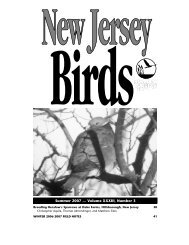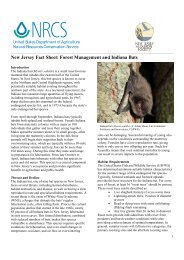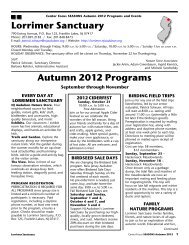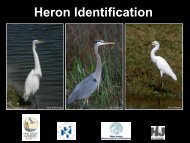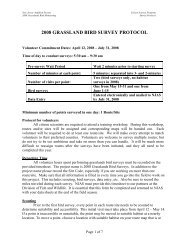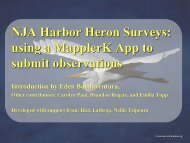March through May, 2009 - New Jersey Audubon Society
March through May, 2009 - New Jersey Audubon Society
March through May, 2009 - New Jersey Audubon Society
Create successful ePaper yourself
Turn your PDF publications into a flip-book with our unique Google optimized e-Paper software.
NOT ACCEPTED<br />
Cape Verde Shearwater Calonectris edwardsii<br />
· <strong>2009</strong>-039. 5 Oct 2008. 80 miles SE Barnegat<br />
Light.<br />
This report relied primarily on a photo, as only a<br />
limited written description was included. The photo<br />
seemed to show a fairly typical-looking Cory’s Shearwater.<br />
There was some anecdotal discussion about the<br />
possibility that the “wrong photo” was presented for<br />
review, however no subsequent information about<br />
the sighting was ever received.<br />
Sharp-tailed Sandpiper Calidris acuminata<br />
· <strong>2009</strong>-052. 6 Sep 2008. Forsythe NWR, Atlantic<br />
Co.<br />
The documentation for this report fell far short of<br />
what would be required for acceptance on the <strong>New</strong><br />
<strong>Jersey</strong> State List. In this age of photo documented<br />
records, those reports not accompanied by a photo<br />
need to include a full description and sound reasoning<br />
for ruling out similar, more common species. Neither<br />
of those criteria was met in this case.<br />
Franklin’s Gull Larus pipixcan<br />
· <strong>2009</strong>-013. 20 Mar 2008. South Amboy, Middlesex<br />
Co. 2 birds.<br />
The photos accompanying this report depicted<br />
two Laughing Gulls. Although a written description<br />
would not likely have swayed the vote, it should be<br />
noted that it would have been nice to hear what<br />
pushed the observer toward the identification as<br />
Franklin’s Gulls.<br />
Bridled Tern Onychoprion anaethetus<br />
· <strong>2009</strong>-055. 7 Sep 2008. Sandy Hook, Monmouth<br />
Co,<br />
As with the previous report, the photos accompanying<br />
the report depicted a species different than<br />
that claimed, as the bird photographed was not a<br />
“dark-backed” tern, and appeared to be a young<br />
Common Tern. Again, though a written description<br />
would not likely have swayed the vote, it would have<br />
been educational to hear what pushed the observer<br />
toward Bridled Tern.<br />
Thick-billed Murre Uria lomvia<br />
· <strong>2009</strong>-015. 16 Jan 2008. Sandy Hook, Monmouth<br />
Co. 3 birds.<br />
While it is certainly possible that the observation<br />
of the three birds involved Alcids, the description<br />
does not rule out either Common Murre or immature<br />
Razorbill. In fact, the description did not definitively<br />
rule out Horned Grebe.<br />
Common Ground-Dove Columbina passerina<br />
· <strong>2009</strong>-062. 17 Jul 2008. Merrill Creek Res., Warren<br />
Co.<br />
As more than one committee member noted,<br />
this was a “tantalizing report”. On the one hand, the<br />
time of year is perfect for juvenile Mourning Dove,<br />
which is quite scaly in pattern. However, there<br />
were also features noted, such as rufous in the wings<br />
that seemed to rule that out. In the end, there were<br />
enough contradictory elements to the report to push<br />
it into the “Not Accepted” category. Single observer,<br />
non-photo reports of exceptionally rare birds, as is<br />
the case with Common Ground-Dove, need to be<br />
meticulously documented, which was not the case<br />
in this instance.<br />
Mountain Bluebird Sialia currucoides<br />
· <strong>2009</strong>-076. 13 Nov 2008. Great Swamp NWR,<br />
Morris Co.<br />
Another intriguing report, which ultimately was<br />
moved to the “Not Accepted” list due to inconsistencies<br />
in the description. Most specifically, were the<br />
stated “white breast and belly” and a description of<br />
the size as being the same as the Eastern Bluebirds<br />
with which it associated. While the breast and belly<br />
can be paler than the upperparts, they shouldn’t<br />
appear “white”, and likewise the bird should have<br />
looked slightly larger, and especially longer-winged,<br />
than Eastern Bluebird. Again, Mountain Bluebird<br />
is exceptionally rare, and would require a more<br />
convincing description for acceptance on the <strong>New</strong><br />
<strong>Jersey</strong> State List.<br />
Western Tanager Piranga ludoviciana<br />
· <strong>2009</strong>-028. 18 Jun 2008. Forsythe NWR, Atlantic<br />
Co.<br />
The time of year, though not conclusive, was a<br />
red flag for this report. When combined with a thin<br />
description, which did not fully eliminate the other<br />
tanagers or even an oriole, this report was relegated<br />
to the “Not Accepted” list.<br />
Black-billed Magpie Pica hudsonia<br />
· <strong>2009</strong>-034. 3 Feb 2001. Sussex, Sussex Co. 2<br />
birds.<br />
The description of the two birds was barely adequate<br />
enough to suggest that the sighting involved<br />
were Black-billed Magpies, however the origin of the<br />
two birds was at best uncertain, and at worst almost<br />
surely “escapees”.<br />
Tabled Awaiting Further Pattern of<br />
Occurrence<br />
Trumpeter Swan Cygnus buccinator (5)<br />
· <strong>2009</strong>-032. 24 Feb 2008. East Brunswick, Middlesex<br />
84 — <strong>March</strong> <strong>through</strong> <strong>May</strong>, <strong>2009</strong>



